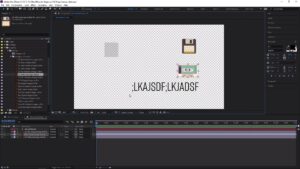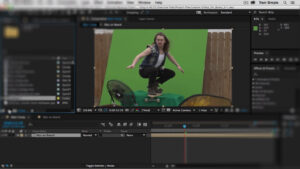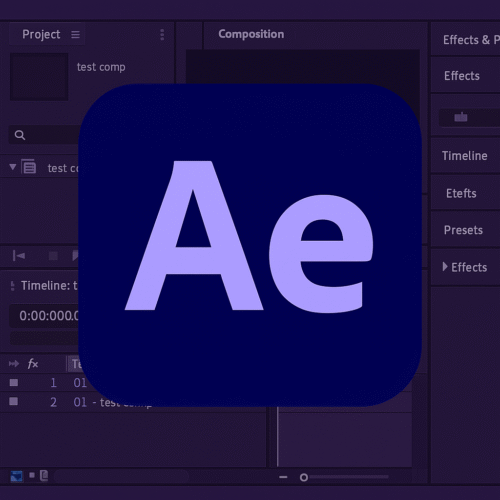Adobe After is one of the best software of Adobe Company. Adobe After is easy to use and also have a friendly Interface so everyone can use this. After Effects is mostly used in films, TV shows, web videos, and interactive media. After Effects also provides a lot of Advanced tools that you can use to create motion graphics, visual effects. You can also customize the After Effects interface according to your needs.
This is also part of Adobe After Effects Tutorial. You can use this software and make your clips or videos more engaging and unique. Creators that have a lot of fan following and those who have the best and unique content also use After Effects to create there videos and clips. If you want to learn about After Effects, you can also use Adobe’s Official website, and you can also learn After Effects by this article.
A Chronicle of Innovation: The Genesis and Growth of After Effects:
The Company of Science and Art (CoSA) is the company that invented After Effects in 1933, with the name of “CoSA After Effects.” But in 1944, Adobe Systems bought CoSA, and then it became After Effects. After this, Adobe promoted After Effects, and now it has become the world’s best animation or editing Software.
In the starting years of After Effects Adobe company focused on basic compositing tools to make this software easy to use. After some years company worked very hard and added new features like Keyframing, motion tracking, and 3D compositing.
These features make your clips or videos more engaging and unique. After some time they introduced expressions, which is JavaScript-based scripting language. Artists use this features to create procedural animations. After this feature, it became very easy to create complex movements or behaviors.
Adobe also have some other software like Premiere Pro, Photoshop, Adobe Illustrator, Adobe INDESIGN, Adobe Lightroom, Adobe Audition, and Adobe Dreamweaver. These are also unique software that you can use in your different projects and make them unique and engaging. If you need some information about Premiere Pro then you can also read my article on Premiere Pro.
Dissecting the Arsenal: A Comprehensive Overview of After Effects’ Features:
After Effects provides a fantastic tool named Multifaceted that allows people to turn their creative ideas into reality. Here are some tools and their explanation:
1: The Composition and Layer Paradigm: The Canvas of Creation:

Composition has a virtual workspace that people use to assemble or animate their layers. And Layer shows single elements like video footage, images, text, and shapes. You can also transform or animate your clips; it gives you full control for this.
2: Animation and Keyframing: Orchestrating Movement:

Keyframing is a tool that is used to create animations. This is one of the best tools in After Effects. People set keyframes at different time points. The tool provides different properties and values of position, scale, rotation, or opacity. Graph Editor is used to control timing or interpolation of animation and its helps to make your motion smooth or natural.
Expressions is a JavaScript-based scripting language that makes it easy to create complex or data-driven animations. Puppet Tools is used to deform or animate images or graphics, and it is also the best tool in After Effects.
3: Visual Effects and Compositing: Crafting Illusions:

Adobe After Effects Tutorial. After Effects also provides a huge library of built-in effects or presets that give features like color correction, distortion, stylization, or compositing. These features make your clips or videos unique or engaging. 3D Compositing is used to import 3d models, and you can easily create 3d text. You can create a full 3d environment from this tool.
After Effects also provides Motion Tracking or Stabilization tools that are used to track a single or multiple things in clips or videos. Stabilization tool helps to stabilize your video and your clips. This is also part of Adobe After Effects Tutorial.
4: Text and Typography: Dynamic Communication:
If you want to add text animation to your clips or videos, you can use After Effects. If you want customize typography or text appearance, then you use the Character Panel, it gives you full control for this. This is also the best tool in After Effects. If you want to do any complex text animation, then you can use Text Animators or Presets.
A lot of people use this tool for complex text animation. And you do not need to do all things manually, this tool provides you an auto system that makes this tool easy and simple for the user. If you want to create or manage any motion graphic templates, then you can use the Essential Graphics Panel, and you can also use these templates in Premiere Pro.
5: Shape Layers and Vector Graphics: Precision and Versatility:
If you want to create or animate shapes, paths, or strokes that are based on vector, then you can use the Shape Layers tool. If you want to draw or paint anything in After Effects, then you can use Vector Paint Tools for this. You don’t need to use any other software for this. This tool is also the best tool in After Effects that makes your work easy and smooth.
6: Motion Graphics Templates (.mogrt Files): Reusable Creativity:
If you want to create or customize any motion graphics, then Motion graphics templates are a game-changer feature for you. You can also use or customize these templates in Premiere Pro and also do editing in text, color, and parameters. You can use the Essential Graphics Panel to create or export graphics and use them in other Adobe Apps smoothly. This feature is best and useful for editing or designing.
7: 3D Camera and Lights: Adding Depth and Realism:
If you want to make any realistic lighting effects, then you can use the 3D Camera or Lights feature. A lot of people are using the same feature to make realistic lighting effects. If you want dramatic or professional animations or visual effects, then this is the best tool or feature for you because this feature auto-adds depth or realism in your clips.
This feature is especially for those people who want any cinematic touch in their videos or clips. This is also a great feature or tool in After Effects.
8: Roto Brush and Refine Edge: Precise Isolation:
If you want to extract foreground elements from the background in video footage, then you can use Roto Brush or Refine Edge. This tool is important or most powerful tool in After Effects. If you want to select anything urgent from the background, then you can use the Roto Brush tool.
This tool makes this work easy and smooth. If you want to select anything more accurately or cleanly, then you can use the Refine Edge Tool. This is also the best tool of After Effects. If you don’t have a green screen, then you can use these tools. It makes your clip more professional.
9: Content-Aware Fill and Generative Fill: Object Removal and Expansion:
If you want to fill space in videos with surrounding pixels, then you can use the Content-Aware Fill tool. This is the tool that can automatically fill space in videos with the surrounding pixels. If you want to remove unwanted objects from your clips, then you can use this tool.
10: AI-Powered Features: Enhancing Efficiency and Creativity:
After Effects recently added a new AI-powered feature that makes your work very easy and smooth. If you want to do your work fast, then you can also use this feature. A text-based tool transcribe your video and also gives you the option to edit the text.
This tool also makes your work easy and smooth. You can seamlessly extend your clips naturally with the Generative Extend tool. This tool auto-adds new AI frames in video or clips that make you clip naturally.
Optimizing Performance and Troubleshooting Common Issues:
After Effects can be resource-intensive, and users may encounter occasional performance issues. Optimizing performance and troubleshooting common problems are crucial for a smooth workflow.
Minimum System Requirements For Windows:
Processor: Intel® 6th Generation or newer CPU or AMD Ryzen™ 1000 Series.
Operating System: Windows 10 (64-bit) version 22H2 or later.
Memory (RAM): 16 GB
GPU: Windows with NVIDIA GPU: GPU must be of the Maxwell generation or newer and have at least 4GB of VRAM <br> Windows with Intel or AMD GPU: Discrete GPU with at least 4GB VRAM.
Display: 1440×900
Minimum System Requirements For MacOS:
Processor: Intel® 6th Generation or newer CPU
Operating System: macOS 12 (Monterey) or later
Memory (RAM): 16 GB
GPU: 4 GB of GPU VRAM
Storage: 8 GB of available hard-disk space for installation; additional free space required during installation.
Recommended System Requirements For Windows:
Processor: Intel® 11th Gen or newer CPU with Quick Sync or AMD Ryzen™ 3000 Series / Thread ripper 3000 series or newer CPU.
Operating System: Windows 10 (64-bit) version 22H2 (or later) or Windows 11.
Memory (RAM): 16 GB of RAM for HD media, 32 GB or more for 4K and higher.
Storage: Fast internal SSD for app installation and cache Additional high-speed drive(s) for media.
GPU: 8 GB of GPU Memory.
Recommended System Requirements For MacOS:
Processor: Apple Silicon M1 or newer.
Operating System: macOS 13 (Ventura).
Memory (RAM): 32 GB or more
GPU: 8 GB of GPU VRAM
Storage: Fast internal SSD for app installation and cache Additional high-speed drive(s) for media.
Display: 1920×1080 or greater DisplayHDR 1000 for HDR workflows.
These are the some system requirements that you need for smooth editing.
The Future Horizon: Embracing Innovation and Evolution:
Adobe is continuously making After Effects better and better, like they just added AI and machine learning. These all changes and updates show that in the future, After Effects will become the world’s best editing software.
FAQs:
- What is the difference between Adobe Premiere Pro and Adobe After Effects?
- Premiere Pro is primarily used for video editing, while After Effects is used for motion graphics and visual effects.
- Is After Effects difficult to learn?
- After Effects has a steep learning curve, but with practice and dedication, it can be mastered.
- What are motion graphics templates (.mogrt files)?
- .mogrt files are reusable motion graphics templates that can be customized in Premiere Pro.
- What are some common uses of After Effects?
- Common uses include creating visual effects for films, motion graphics for television, and animated graphics for web videos.
- What are the system requirements for Adobe After Effects?
- It is recommended to have a computer with a powerful processor, sufficient RAM, and a dedicated GPU. Check the official Adobe website for the most up-to-date requirements.
Conclusion:
After Effects is the software that provides visual creativity complete orchestra. Where all tools and features will create motions and illusions, and you can use these to make magic. After Effects is best for those people who love to make motion graphics or visual effects. This is the only software that provides Advanced animation capabilities, Powerful compositing tools, and seamless integration.
You can change your imagination into reality by using this software. After Effects provides AI, machine learning, and automation features. These are the features that make this software the world’s best. If you want more tech info then you can also visit my full website.
Click Here To Download

3 thoughts on “Best Adobe After Effects Tutorial for Beginners – Top 01 Ultimate Guide”